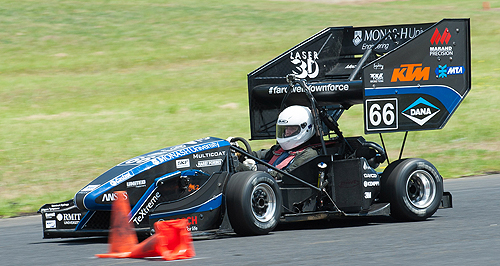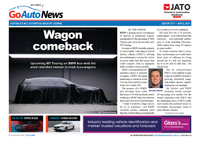Make / Model Search
News - General NewsMonash wins Formula SAE-A againCatching up: Edith Cowan University’s entry in this year’s Formula SAE-A competition came second behind Monash University. Edith Cowan Uni closes the gap with radical Honda-based motor and transmission22 Dec 2014 By IAN PORTER MONSAH University has extended its winning streak in the Formula SAE-A competition to six in a row this year, with assistance from a CSIRO skunkworks specialising in 3D printing. The team emerged victorious after a grueling two-day contest between the 26 teams that congregated at Calder Park near Melbourne. International teams came from New Zealand, Japan, South Korea, India and Poland. Second for the third year in a row was Edith Cowan University (ECU) from Western Australia, which dramatically closed the gap to Monash this year, with the smallest margin ever recorded – 881 points to Monash’s 915.5 points. Third home was the top international entry, the University of Auckland, on 870.6 points. Monash won six of the eight tests that make up the Formula SAE-A evaluation program. The cars from Monash and ECU both contained some serious engineering, with Monash calling on the CSIRO’s Lab 22 additive manufacturing centre to produce suspension uprights for its racecar. All four hubs on the car were made using a cutting-edge process employing an electron beam to build up the hubs in titanium. Monash Motorsport team leader Edward Hamer told GoAuto about the strength of the university’s entry. “The electron beam process gives a truer density of metal. It’s got incredible strength properties,” he said. “We were lucky enough to present a design to them and they’ve been working with us with this process to work out what requirements there are for post-machining and managing the heat during the process. “This was one of the first parts they had made that went on a car. It went amazingly well.” Using the additive manufacturing process allowed the creation of shapes that can’t be made on a CNC (computer numerically controlled) machine, like organic shapes and internal cavities, Mr Hamer said. The printing of titanium hubs not only saved weight on the finished product, it consumed less titanium and produced a stiffer part with less material. Mr Hamer said the Monash team also added a turbocharger to its single-cylinder KTM 450cc power unit, gaining 30 per cent more power and 25 per cent more torque. This big power boost was augmented by the introduction of a traction control system to limit wheelspin. The Edith Cowan University team from WA made huge progress this year, lifting their score from 754.2 points in 2013 to 881 points. The team completed a four-year project this year when it finally replaced the engine block and gearbox housing from its Honda CBR 600cc unit and substituted a custom-made unit comprising the engine block, the gearbox housing and the differential. The Honda cylinder head and camshafts were retained, while the number of gear ratios was cut to just two. “Our mission was to make our car simpler and lighter,” ECU team leader Alex Barry told GoAuto. That huge project resulted in an engine that was more compact, lighter and sat lower in the chassis, giving better centre of gravity. “Our centre of gravity was 180mm while most of the other cars were around 250mm. We raised a few eyebrows with that,” he said. In addition, the team opted for the lighter, but slightly less effective, de Dion rear axle to save weight. “We had about 86bhp and weighed 184kgs. Our old car weighed 200kgs. “Other cars are more powerful, but they weighed more,” Mr Barry said. The team looked at turbocharging, but that would have added 30kgs to the weight, Mr Barry said. The first electric car home was the RMIT University Electric, which placed seventh on 696.5 points. It was the seventh electric car RMIT has entered in Formula SAE-A and the 2014 team completely redesigned the drivetrain, installing a single permanent-magnet AC motor with a limited slip differential. RMIT Faculty Advisor Graham Holmes said the 2014 team had set out to develop an all-new powertrain and finish in the top 10. “To their credit, they met all of their goals, they built a car that was completely reliable and finished well within the top 10,” Mr Holmes said. “This year we got the new car’s powertrain up and running. Next year we want to realise its full potential.” Formula SAE-A is a world-wide competition for engineering students at tertiary institutions. They have to build a car to exacting parameters that place real-world limits on what can be done through rules that restrain cost and complexity. The teams are scored in eight different disciplines, with non-dynamic areas included like costing, business case and design. The dynamic testing includes an acceleration test, an autocross contest, a skid-pad test and an endurance run that tests reliability and fuel consumption. The annual show-down is organized by the Society of Automotive Engineers Australasia.  Read more |
Click to shareGeneral News articlesResearch General News Motor industry news |











Facebook Twitter Instagram